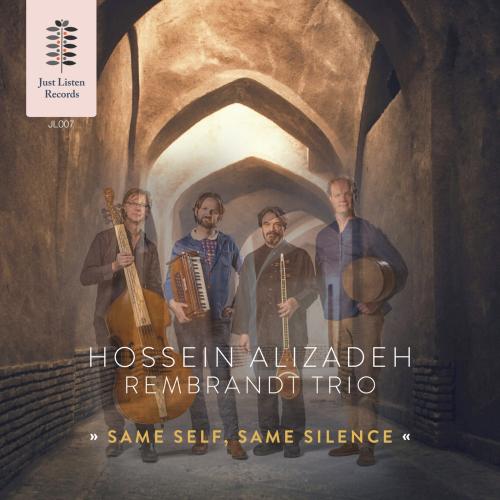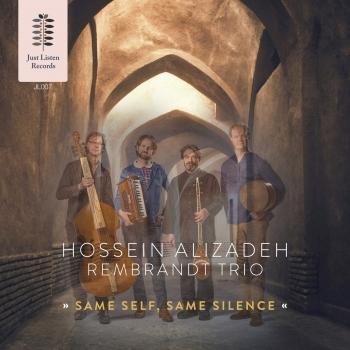
Same Self, Same Silence Rembrandt Frerichs Trio & Hossein Alizadeh
Album info
Album-Release:
2020
HRA-Release:
26.08.2022
Album including Album cover
- 1 Daramad 09:36
- 2 Sama 09:36
- 3 Kereshmeh 04:08
- 4 Intro to Neyshaburak 02:54
- 5 Neyshaburak 05:34
- 6 Sarmast 07:39
- 7 Rembrandinejad 03:34
- 8 Nahoft 08:37
- 9 Torkeman 10:07
Info for Same Self, Same Silence
“The sound of the fortepiano very much suits our modern time,” Frerichs notes. “It is an instrument that connects cultures.” On his new album, “The Contemporary Fortepiano,” he takes the listener on a world tour comprising 15 musical miniatures that each highlight a different aspect of the ensemble.
Rembrandt has a personal style that is driven by content rather than virtuosity. His music invariably carries an artistic message, which is informed by his world travels. This gives his work an additional dimension; Rembrandt integrates elements of Arabic music into a new concept, seamlessly connecting East and West. He feels equally in his element while playing the percussive 18th century fortepiano, a 19th century harmonium or his modern grand piano. With violone player Tony Overwater and percussionist Vinsent Planjer, he forms a unique-sounding trio, whose subtle style is its own trademark.
Together, Hossein Alizadeh, Rembrandt Frerichs, Tony Overwater and Vinsent Planjer represent three art music traditions – Persian, European and jazz – and make from them a unified creation.
Same Silence, Same Self is an exploration of Nava, one of the seven principle dastgāhs – or modal systems – in Persian classical music. A dastgāh is defined by a particular set of notes, and so each has its own distinct emotional colour and personality. Nava is one of the oldest in the dastgāh system, known for its serenity and the meditative qualities it imbues. Yet, it remains among the least performed in the Persian repertoire.
Each piece here uses Nava as its base, anchoring the music solidly in the classical tradition. Most of the pieces are based on gushehs, short canonical melodic fragments upon which ideas can take flight; others are specially com- posed by Alizadeh; and still others are solo improvisations on the dastgāh from Alizadeh and Frerichs.
The serenity embodied by Nava can also be heard in the performances themselves. Alizadeh and the Rembrandt Trio first met in 2016, and performed together for the first time that same year at the November Music festival in ’s-Hertogenbosch, the Netherlands. When recording this album, Alizadeh said “I’ve known these guys for a year now and I already feel we have known each other for fifty years, because we have grown so close musically so fast.” This collaborative closeness gives the ensemble a relaxed enjoyment that can be heard clearly in the music, a feeling that only adds to the emotional depth on display.
To make Same Silence, Same Self, each musician has adapted their playing to the others’. Musical minds are tuned to each other’s thinking, and musical instruments are re-tuned to ring in sympathy with another culture – Nava is a dastgāh that requires the use of quarter-tones not usually found in European music. This reorientation allows each musician to approach on an equal foot- ing, to build new sonic possibilities. “When we start to play,” says Alizadeh, “we become like sculptors who create a shape on stage and, bit by bit, we carve out a sculpture.”
Where else could this music be heard than the here-and-now? The jangling buzz of the shurangiz complements the dampened tones of the fortepiano; rhythms from Iran played on a whisper kit are elaborated on the violone; impro- visations glide seamlessly between Asia, Europe and America. Classical music cultures from the far past meet in the present.
These are the sounds of the modern and the ancient. (Liner Notes by Jim Hickson, London, UK, 2020)
Hossein Alizadeh, shurangiz
Rembrandt Trio:
Rembrandt Frerichs, portepiano & harmonium
Tony Overwater, violone
Vinsent Planjer, whisperkit
Hossein Alizadeh
(Tehran-1950) is considered one of the most important figures in contemporary Persian music. He comes from a traditional training. He learned the Radif of Persian classical music with various masters of the tradition including PortraitHoushang Zarif, Ali Akbar Shahnazi, NurAli Borumand, Mahmood Karimi, Abdollah Davami, Yousef Foroutan, and Saied Hormozi and later recorded the entire body of the Radif based on the interpretation of Mirza Abdullah for Tar and Setar. He also received a BA in Music Composition and Performance from the University of Tehran and later studied Composition and Musicology at the University of Berlin. He has taught at the University of Tehran and the Tehran Music Conservatory.
Alizadeh has led a solo career, performing both in Iran and throughout North America, Europe and Asia. He was the conductor and soloist in the Iranian National Orchestra of Radio and Television, established the acclaimed Aref Ensemble and worked with the Shayda Ensemble. His first professional experience in Europe was playing in the orchestra of the famous Bejart Ballet Company in Maurice Bejart’s ballet, Gulistan.
Some of Alizadeh’s most noted compositions are The Nava Improvisations (1976), Riders of the Plains of Hope (1977), Hesar (1977), Revolt (1983), Ney Nava (1983), Dream (1986), Torkaman (1986), Raz-O-Niaz (1986), Delshodegan (1987), Song of Compassion (1991), New Secret (1996), A Time for Drunken Horses (2000), Turtles can Fly (2004), Endless Vision (2004), Nive Mang (2006), Under the Razor (2007) and Ode to Flowers (2007). The album, Endless Vision has been nominated for the Best World Music Album of the Year 2006 in the 49th Edition of the Grammy Awards.
Alizadeh established the Hamavayan Ensemble in 1989 with a new approach to the traditional Iranian choral singing. Accompanied with traditional instruments, this ensemble has appeared in many of Alizadeh’s compositions including New Secret, Gabbeh, Songs of Compassion and Endless Vision.
Rembrandt Frerichs Trio
has been active on the international concert stages for the last 12 years. Besides pianist Rembrandt Frerichs, the trio is formed by renowned bassist and composer Tony Overwater – winner of the Dutch VPRO / Boy Edgar Price – and percussion innovator and composer Vinsent Planjer. Their music is often described as poetic, visual and impressionistic. The trio performed at the North Sea Jazz Festival several times and has a busy touring schedule each year.This year, they have been, among other places, to Iran, Taiwan, Indonesia, London’s Barbican Centre and countries in countries in Europe, performing in full concert halls each time.
This album contains no booklet.










